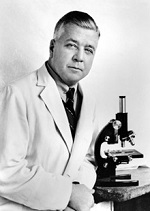|
TRANSLATE THIS ARTICLE
Integral World: Exploring Theories of Everything
An independent forum for a critical discussion of the integral philosophy of Ken Wilber
  Frank Visser, graduated as a psychologist of culture and religion, founded IntegralWorld in 1997. He worked as production manager for various publishing houses and as service manager for various internet companies and lives in Amsterdam. Books: Ken Wilber: Thought as Passion (SUNY, 2003), and The Corona Conspiracy: Combatting Disinformation about the Coronavirus (Kindle, 2020). Frank Visser, graduated as a psychologist of culture and religion, founded IntegralWorld in 1997. He worked as production manager for various publishing houses and as service manager for various internet companies and lives in Amsterdam. Books: Ken Wilber: Thought as Passion (SUNY, 2003), and The Corona Conspiracy: Combatting Disinformation about the Coronavirus (Kindle, 2020). TABLE OF CONTENTS | REVIEWS
What's Up With These “Koch's Postulates”?The Corona Conspiracy, Part 16Frank Visser
"Koch's postulates have been recognized as largely obsolete by epidemiologists since the 1950s" (Wikipedia).
Two of the most frequent claims made by virus denialists have been: "the PCR test doesn't test for a virus, but for human genetic material" (Icke) and "the classic Koch's Postulates have not been met for this virus" (Kaufman). This makes sense for them, because if there is no virus at all, what else can a test do than match some genetic sequence of our own? And if there's no virus at all, there's no viral disease and no way of proving that a virus causes the disease, in our case Covid-19. We will tackle both claims in this article.
Do we know the SARS-CoV-2 virus exists? Do we know it is the cause of Covid-19? Asking these questions is legitimate. Ignoring progress made in modern virology isn't.
‘The PCR Test Doesn't Test for a Virus’Let's assume we have a group of 100 persons, 5 of which have Covid-19. Let's further assume we have an ideal PCR test for Covid-19, which picks up all cases in this group without any error, and no other virus. So we disregard the usual instances of false positives (you are healthy but get a positive test) or false negatives (you are ill but get a negative test). Instead, we have only these four possible outcomes of a PCR test:  So, to walk you through this diagram: test results can be positive (you have the virus) or negative (you don't have the virus). You can have symptoms or no symptoms. A healthy person without any symptoms will get a negative test (A). A sick person with Covid-19 symptoms will get a positive test (C). 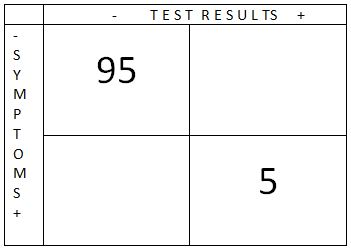
Group of 100 persons, 5 of which have SARS-CoV-2
Ideal situation: all 5 symptomatic cases are found Two cases complicate the situation: in "asymptomatic" cases a person has the virus but no symptoms (B), and when a person has a virus other than SARS-CoV-2, like the flu, he will test negative (D)—and that's correct, for he doesn't have SARS-CoV-2. 
Group of 100 persons, 5 of which have SARS-CoV-2
(2 symptomatic, 3 asymptomatic), 5 have flu virus If, however, the PCR test would not test for any virus but for general human genetic material, such as exosomes, as Kaufman claims (see Part 2), or parts of a human chromosome, such as chromosome 8, as the latest rumor has it (see Part 15), the expected test results would be dramatically different. 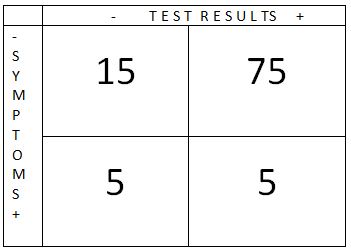
When test matches part of our human genome:
80 false positives, 20 false negatives In that case we would expect, say, 80% "false positives" (where human genetic material is matched) and 20% "false negatives" (where this human genetic material is missed, for whatever reason: the test might have failed or that particular genetic sequence did not turn up in the sample taken from a patient). In the current situation, where the number of positive test results rarely rises above 10%, we can therefore dismiss this hypothesis as nonsensical. We simply don't see that many positive test outcomes. Another frequently heard interpretation of "the PCR test doesn't test for a virus" runs like this: it test for only a very small part of the virus (see Part 13). That is, of course, a truism, because the whole point of this test is that a small part of the full genome of SARS-CoV-2 is detected as a fingerprint or signature. A fingertip is only a very small part of the human body, but we recognize a person by his or her fingerprint, because they are unique. A more reasonable and relevant interpretation is: we are never 100% sure that this signature sequence represent a fully active virus, or is only a fragment of a dead virus. That's an empirical question to be answered by research. And that's why test results should always be accompanied by clinical observations of a patient, to get to a fuller picture. Of course, we have left the field of virus denialism here, because to talk of a "fragment of a virus" one has to believe in the existence of viruses in the first place. ‘The Virus Has Never Been Isolated’
A more serious claim of virus denialists is that "the virus has never been isolated." Reference is made to the famous Koch's Postulates, and to understand their impact and historical relevance we need to dig into some medical history, so bear with me. The problem is about deciding what exactly causes a disease. When can we confidently conclude that a certain germ causes a certain disease? For the purpose of this article we will take Wikipedia as our guide, because it offers a high-level and historically interesting view of the subject. 19th Century: Robert KochRobert Koch (1843-1910) was a Jewish born German physician and microbiologist. As one of the main founders of modern bacteriology, he identified the specific causative agents of tuberculosis, cholera, and anthrax and also gave experimental support for the concept of infectious disease, which included experiments on humans and animals. Koch received the Nobel Prize in Physiology or Medicine in 1905. He formulated a series of four generalized principles linking specific microorganisms to specific diseases:
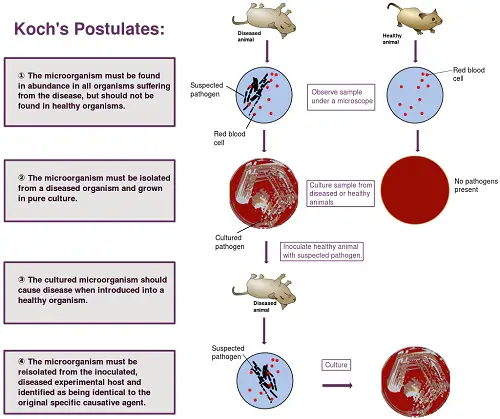
Koch's postulates of disease.
This applies primarily to bacteria, as viruses were not yet observed in his days. Contrary to bacteria, which can be cultured on a petri dish, viruses only multiply within cells. Even Koch himself realized that these four postulates would not always work well with viruses, for the following reasons.
It is clear from the above that Koch's Postulates are not set in stone for viruses. Wikipedia is very clear on their minor relevance for today's world: Koch's postulates were developed in the 19th century as general guidelines to identify pathogens that could be isolated with the techniques of the day. Even in Koch's time, it was recognized that some infectious agents were clearly responsible for disease even though they did not fulfill all of the postulates. Attempts to apply Koch's postulates rigidly to the diagnosis of viral diseases in the late 19th century, at a time when viruses could not be seen or isolated in culture, may have impeded the early development of the field of virology. Koch's postulates have been recognized as largely obsolete by epidemiologists since the 1950s, so, while retaining historical importance and continuing to inform the approach to microbiologic diagnosis, they are not routinely used to demonstrate causality. (emphasis added) Good to keep this in mind when we deal with virus denialists later on.
Attempts to apply Koch's postulates rigidly to the diagnosis of viral diseases in the late 19th century, at a time when viruses could not be seen or isolated in culture, may have impeded the early development of the field of virology.
20th Century: Thomas RiversThomas Milton Rivers (1888-1962) was an American bacteriologist and virologist and is called the "father of modern virology." To upgrade Koch's Postulates for the 20th centry, especially in the context of viruses, Thomas Rivers formulated a few additional postulates.[1] Here I am following Andrew Kaufman's presentation[2]: 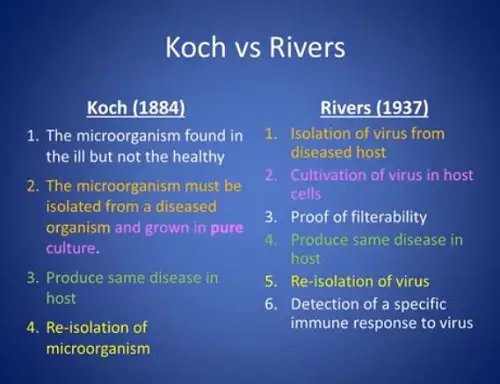
Source: Andrew Kaufman, "Evidence that Viruses Cause Disease".
Kaufman claims that the first postulate of Koch has been eliminated by Rivers, but this is clearly in error. In his "Viruses and Koch's postulates" (1937) Rivers clearly states as one of the two main principles: "A specific virus must be found associated with a disease with a degree of regularity." Not in an absolute but a relative sense. As you can see, the requirement to isolate the microorganism and grow it in pure culture, has been replaced by "cultivation of virus in host cells". This makes sense, because viruses can only grow in cells, not in a neutral medium. Filterabillity is also typical for viruses. Viruses being very small, they can be separated from cells by certain filters. And immune responses too are specific for viruses. In one of his slides, Kaufman states, with exclamation marks: "genetic material (DNA, RNA) is not mentioned in any of the criteria!!!" Well, perhaps that's because at the time of Rivers' article (1937), DNA wasn't yet discovered? The structure of DNA was found only in 1953, and the code was cracked in subsequent years. DNA sequencing became a huge industry, and whole genome sequencing is a 21st century effort. 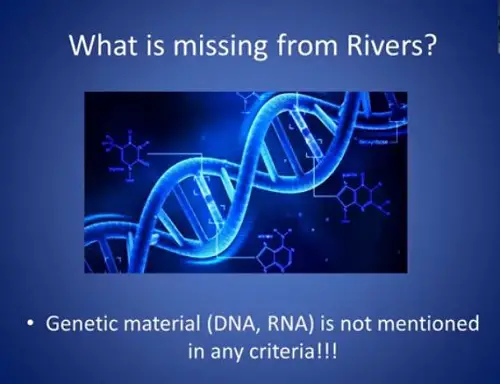
Note: this DNA helix turns the wrong way: left-handed instead of right-handed.
This statement is a bit ambiguous. Most probably Kaufman suggests that, because genetic material isn't mentioned in Rivers' postulates, we can safely ignore it. A more interesting interpretation is: perhaps these postulates too are in need of revision. In his 1936 Presidential Address to the Society of American Bacteriologists, Rivers foresaw that even his amendments to Koch would be superseded by new insights and rules[3]:  So let's move on to the next century—that's where the real action is. 21th Century: David FredericksAgain, Wikipedia puts things for us in historical perspective: More recently, modern nucleic-acid-based microbial detection methods have made Koch's original postulates even less relevant. These methods enable the identification of microbes that are associated with a disease, but which cannot be cultured. Also, these methods are very sensitive, and can often detect very low levels of viruses in healthy people. (emphasis added) Dr. David N. Fredricks is an infectious disease specialist in Seattle, Washington and is affiliated with multiple hospitals in the area. He has been in practice for more than 20 years. Fredericks and Relman formulated new principles of disease causation, taking into account the genomic revolution.[4] (See Part 6 for some general principles).
Even with these updated "thoughts and guidelines" (Fredericks), no categorical statements can ever be made about microorganisms being the cause of a disease. These guidelines are all stated in relative language ("preferentially", "fewer", "decrease", "more likely", "consistent"). From the web of knowledge gathered by various sources, a scientific consensus arises. The step from association to causation is more or less a philosophical one. This concludes our historical overview of Koch's Postulates and later amendments, caused by the progress of the science of virology. We are not living in the nineteenth century anymore. DO VIRUSES ACTUALLY CAUSE DISEASE?
Instead of insinuating that these Chinese researchers—who have published the full genome of SARS-CoV-2 in record time—have made this all up, could it be that they just don't care about this "isolation" step anymore because science no longer works this way?
Andrew Kaufman, "Koch's Postulates: Have They Been Proven for Viruses?".
To his credit, Andrew Kaufman has done a close reading of both Koch's and Rivers' postulates, in the context of SARS-CoV-1 and SARS-CoV-2. I have included his presentation above for you to browse through. But when it comes to current virology, his expertise quickly seems to peter out. He seems obsessed with the fact that the SARS-CoV-2 virus has never been isolated according to old fashioned virological standards, implying that this puts the whole of the virological enterprise at stake. A similar attitude can be found in Torsten Engelbrecht, author of Virus Mania, the bible of the virus deniers. He wrote an article provocatively titled "COVID19 PCR Tests are Scientifically Meaningless"[5] (which got published on the conspiracy website off-guardian.org, not any serious scientific magazine). In this article he describes that he approached several of the early Chinese researchers with the question if they had "purified" the new SARS-CoV-2, to which they politely replied with: "No we did not". We asked several study authors “Do your electron micrographs show the purified virus?”, they gave the following responses: Instead of insinuating that these Chinese researchers—who have published the full genome of SARS-CoV-2 in record time—have made this all up, could it be that they just don't care about this "isolation" step anymore because science no longer works this way? These self-appointed no-virologists are two centuries behind the times. They look a lot like this cruise ship passenger, who is disoriented in the new digital world:  Sextant A passenger on a cruise ship sailing in the middle of the Pacific Ocean is harassing the captain about the current position of the ship. Likewise, Kaufman seems lost in the genomic sea, when he argues: 'The main point: we don't know where these sequences came from.'[7] When viruses are cultured in so called Vero cells (kidney cells from African monkeys), or viral samples are taken from human patients, researchers don't run the risk of confusing these mammalian cells with viruses, because both can be sequenced to the minutest detail. Microscopes have been replaced by highly sophisticated sequencing equipment. This is the progress of science. Everything under the sun has been genomically sequenced these days: humans, neanderthals, fossil bones, animals, plants, fungi, bacteria, archaea and even viruses. The truth is, modern virologists do recognize a viral sequence when they see one. 
nCoV_IP2-12696bProbe+ sequence in SARS-CoV-2 genome.
Do we know the SARS-CoV-2 virus exists? Do we know it is the cause of Covid-19? Asking these questions is legitimate. Ignoring progress made in modern virology isn't. NOTES[1] Rivers, T. M. 1937. Viruses and Koch's postulates. J. Bacteriol. 33:1-12. [2] Andrew Kaufman, "Evidence that Viruses Cause Disease or The Rooster in the River of Rats", www.youtube.com. This video has been removed for violating YouTube's Terms of Service. Available from another Youtube user. [3] Rivers, p. 4. [4] Fredricks, David; Relman, David (January 1996). "Sequence-Based Identification of Microbial Pathogens: a Reconsideration of Koch's Postulates" (PDF). Clinical Microbiology Reviews. 9 (1): 20-21. [5] Torsten Engelbrecht & Konstantin Demeter, "COVID19 PCR Tests are Scientifically Meaningless", off-guardian.org, Jun 27, 2020. [6] Pepijn van Erp, personal communication, Twitter, Sept. 6, 2020. [7] David Icke & Andrew Kaufman, "Chromosome 8 w/ David Icke and Dr. Kaufman", www.youtube.com, August 24, 2020. This video has been removed for violating YouTube's Terms of Service. Available from Bitchute.com
83 Vaccine Myths from docbastard.net
To all those who claim SARS-CoV-2—or any virus—does not exist: the virosphere consists of 7 realms
11 kingdoms, 22 phyla, 4 subphyla, 49 classes, 93 orders, 12 suborders, 368 families, 213 subfamilies, 3,769 genera, 86 subgenera, 16,215 species. Take that.
https://talk.ictvonline.org/taxonomy/
A summary of early parts of this series has appeared in the Dutch magazine Skepter 33(3), September 2020, as "Viruses don't exist" (covering Parts 1-5). German: Skeptiker (December 2020); English: Skeptic.org.uk (January 2021)
Comment Form is loading comments...
|

